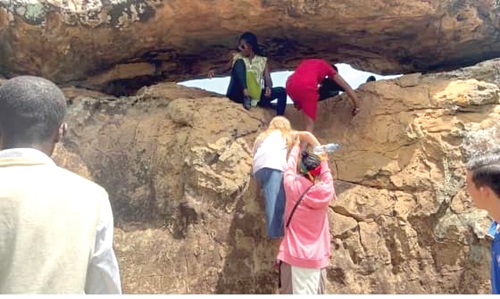
The Bono East Region, with a land mass of 23,654 square kilometres, is rich in natural beauty and cultural heritage, offering a wealth of tourism opportunities waiting to be explored and developed.
With 11 municipal and district administrative areas, the region stands out as one of the country’s emerging tourism destinations.
As the fourth largest region in the country, with a population of approximately 880,921 according to the 2021 Population and Housing Census, the region is strategically positioned to become a key player in the national tourism industry.
Surrounded by diverse natural and cultural attractions, the region boasts a wide array of tourism potentials from scenic landscapes and wildlife to historical sites and cultural festivals.
Despite its many treasures, only a few of the many beautiful gifts from nature have been developed to generate revenue for the region.
Tourist sites
The developed sites are the Kintampo Waterfalls and Canopy Walkway, the Boabeng Fiema Monkey Sanctuary and the Digya National Park.

One of the caves where slaves were kept at the Kunsu, which is yet to be developed
The region’s untapped sites are the Africa-Shaped Rock at Buoyem, the Amoowi Hole and Cave at Pinihini and the Bono Manso Slave Market, Ayandasuo Pan and the Buoyem Bat Colony.
Other potential sites are Busini Poma at Amoma, the Forikrom Boten Shrine and Cave, the Kunsu Slave Market, the Bono Manso Plunge pool, the Kristoboase Monastery, the Atea Forest, the Volta Lake at Yeji and the Techiman Market.
The famous region can play a central role in the country’s tourism industry if all the underdeveloped tourism sites are developed to attract tourists.
Issues
The Bono East Regional Director of the Ghana Tourism Authority (GTA), Joseph Appiagyei, told the Daily Graphic that some of the sites had ownership and other issues, making it difficult for them to be developed.

Tourists arrive at the Tanoboase Sacred Grove
He mentioned the Kintampo Fuller Falls and the Geographical Centre of Ghana at Kintampo and the Dandwa Waterfalls at Dandwa as some of the sites with issues.
Appiagyei explained that the development of the Tanoboase Sacred Grove was ongoing and that the project was near completion.
He said his outfit had enquired about drilling a borehole with an estimated cost of GH¢18,000.
“We have requested an invoice from the driller for onward submission to the head office so that the necessary funds are released for the commencement of the borehole project,” he said.
Appiagyei explained that the site could not be inaugurated without resolving the borehole and electricity issues.
He underscored the need for the site managers to make the necessary documents available for the site’s registration.
Kintampo Waterfalls
The Kintampo Waterfalls and Canopy Walkway is one of the highest falls in the country, attracting hundreds of people from all walks of life daily.

The untapped Bono Manso Waterfalls
Located four kilometres from the Kintampo town on the Kintampo-Tamale highway, it takes its source from the Pumpum River, a tributary to the Black Volta, which falls some 70 metres down on beautiful rocky steps to continue its journey towards the Black Volta at Buipe.
The well-developed site consists of three unique stages, which can be accessed by footpaths.
The final stage offers an exciting twist as tourists can only access the beautiful waterfall by descending a newly constructed windy flight of 173 stairs and ascending a 153-step staircase to enjoy the breathtaking view of the waterfalls.
The canopy walkway has been constructed at the site, spanning 90 metres and 80 metres at two locations at the falls, taking a maximum load of 20 persons, each weighing 100 kilogrammes.
There is also a rest stop and a two-star-rated accommodation in the neighbourhood of the tourist site for tourists who may need to rest or stay overnight.
Boabeng Fiema
Another exciting site in the region is the Boabeng Fiema Monkey Sanctuary in the Nkoranza North District.

Joseph Appiagyei, Bono East Regional Director of the Ghana Tourism Authority
It hosts a rare breed of monkeys, which are considered citizens of the town.
The interesting sanctuary was created in 1974 to protect the sacred monkeys that inhabit the forest around Boabeng and Fiema.
The sanctuary, which accommodates tourists, is home to the Black and White Colobus monkeys and Mona monkeys.
The monkeys have become part of the Boabeng and Fiema communities because they sometimes go to the communities to live with the residents.
Bono Manso
Bono Manso, which is located off the Techiman-Kintampo road, was where slaves from the north were graded and sorted.

Some tourists climbing a rock at the Tanoboase Sacred Grove
According to history, the strongest captives were selected and sent to the coast, leaving the weaker ones in the town.
In the same community, a magic pan, known in Akan as “Ayadasuo”, performs miracles.
History has it that the pan fell from the sky along with a strange chain, with its composition, whether gold or silver, still unknown even after several studies have been conducted.
The pan contains water, which is said to be used for several purposes, including saving lives and commanding rain to fall when the need arises.
Plunge Pool
Also, the community has a waterfall, which is 100 metres from the Techiman-Kintampo highway.

An antelope at the Digya National Park
The Bono Manso Waterfalls, a seven-metre cascade, provides a breathtaking view.
Although not developed, the site is gradually becoming a popular ecotourism destination.
Until recently, the waterfall, cascading from enormous rocks into a tranquil plunge pool, was more of a holy location than a tourist destination where Christians visited to pray.
Digya Park
The Digya National Park covers an area of 349 square kilometres of undulating terrain with sandstone and deep forest.
The second largest park in the country has about six primate species such as the Black and White Colobus monkey, elephants, varieties of antelopes, manatee and clawless Otter.
Moreover, the Buoyem Sacred Grove contains different kinds of animals, including a large colony of fruit bats with over 20,000 roosts in underground caves.
Rodents and avifauna are high in numbers and typical of transitional vegetation that offers varied habitat for forest and grassland species.
The grove is said to have been established in the 14th century to protect the bats, which were food for the traditional authorities and still serve that purpose.
For that reason, the forest has been preserved, though it is not in its original condition.
Kunsu Slave Market
The Kunsu Slave Market is approximately 35 35-minute drive from the Kintampo Waterfalls.

Some tourists at the Tanoboase Sacred Grove
It is a place where enslaved people from northern Ghana were brought into the area for grading and sorting before being transported to coastal forts for shipment to Europe and the Americas during the Trans-Atlantic Slave Trade.
Another interesting site in the region is the Geographical Centre of Ghana.
It is located at the heart of Kintampo, and indicates an exact point denoting the centre of the country.
The site is marked by a monument with Ghana’s Coat of Arms.
Another interesting untapped tourism site with a historic connection to the Bono people is the ancient Amoowi caves at Pinihini near Fiema.
Legend has it that Amoowi was a hole from which the early Bono people emerged to settle at their current locations in the Bono and Bono East regions.
The region is endowed with several tourism potentials and plays a critical role in the country’s hospitality industry.
Hospitality
Statistics from the Regional GTA indicate that the region has 152 formal hospitality facilities.
The facilities comprise 10 two-star hotels, 14 one-star hotels, 126 budget hostels, seven catering and two travel and tour facilities.
While it is evident that much of the region’s natural wealth, particularly the tourism sector, remains untapped, the situation represents a significant opportunity for the government and other investors to invest in the tourism industry to generate revenue, create employment, and boost the region’s tourism sector.
Writer’s email: biiya.ali@graphic.com.gh








